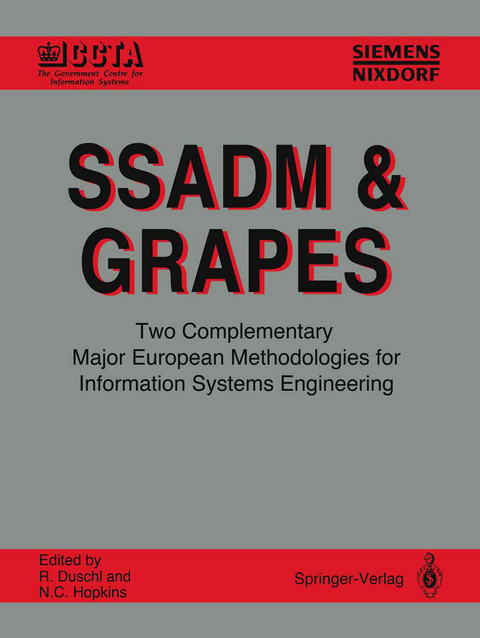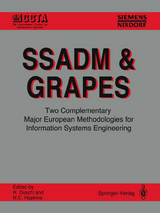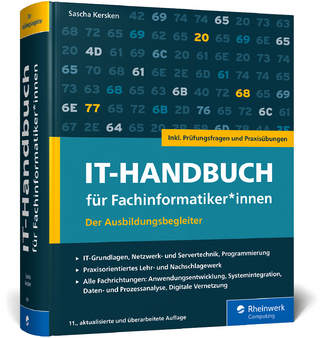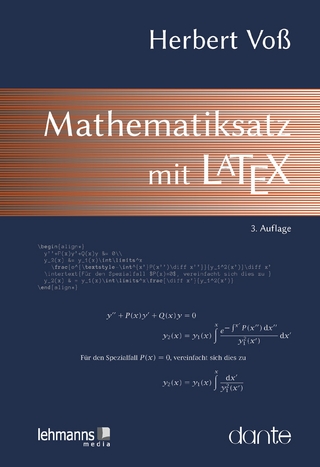SSADM & GRAPES
Springer Berlin (Verlag)
978-3-540-55380-9 (ISBN)
The range of topics covered includes: - identification of the strengths and weaknesses of the two methodologies, - the possibilities of addressing any shortcomings in one approach using techniques employed in the other, - isolation of those aspects of systems analysis and design which are not covered by one of the methodologies - possibly highlighting a need to use an alternative approach.
1 Introduction.- 1.1 Purpose.- 1.2 What is Being Compared?.- 1.3 Intended Audience.- 1.4 Study Assumptions.- 1.5 The Task.- 1.6 The Comparison Study.- 1.7 Overview of the Case Study.- 1.8 Summary.- 2 Overview of Both Methods.- 2.1 Overview of SSADM.- 2.2 Overview of DOMINO/GRAPES.- 3 Motivation, Background and Philosophy.- 3.1 SSADM.- 3.2 GRAPES History and Development.- 3.3 Comparison.- 4 Methodology Style.- 4.1 SSADM Style.- 4.2 GRAPES Style.- 4.3 Comparison of SSADM and GRAPES Styles.- 5 Architecture of the Developed Systems.- 5.1 SSADM Architecture.- 5.2 GRAPES Processing Architecture.- 5.3 Examples of the SSADM Architecture in the Hi-Ho Case Study.- 5.4 Examples of GRAPES's Processing Architecture in the Hi-Ho Case Study.- 5.5 Comparison of the Architecture of End-Products of GRAPES & SSADM.- 6 Life Cycles.- 6.1 The SSADM Life Cycle.- 6.2 The DOMINO Life Cycle.- 6.3 Coverage of the SSADM Life Cycle in the Hi-Ho Case Study.- 6.4 Coverage of the GRAPES Life Cycle in the Hi-Ho Case Study.- 6.5 Comparison of the GRAPES and SSADM Life Cycles.- 7 Fact Representation & Syntax.- 7.1 Fact Representation & Syntax in SSADM.- 7.2 Fact Representation & Syntax in GRAPES.- 7.3 Examples of the SSADM Fact Representation & Syntax.- 7.4 Examples of the GRAPES Fact Representation & Syntax.- 7.5 Comparison of the GRAPES & SSADM Fact Representation & Syntax.- 8 The Knowledge Collection Process.- 8.1 Knowledge Collection in SSADM.- 8.2 Knowledge Collection in GRAPES.- 8.3 Examples of the SSADM Knowledge Collection Process.- 8.4 Examples of the GRAPES Knowledge Collection Process.- 8.5 Comparison of the GRAPES and SSADM Knowledge Collection Processes.- 9 Transformations.- 9.1 Transformations in SSADM.- 9.2 Transformations in GRAPES.- 9.3 Examples of the SSADM Transformations.- 9.4Examples of the GRAPES Transformations.- 9.5 Comparison of the GRAPES and SSADM Transformations.- 10 Conclusions.- 10.1 Answers to Specific Questions.- 10.2 Opportunities for Harmonization of GRAPES and SSADM.- Annex 1.- The Hi-Ho Recruitment Case Study.- The current Hi-Ho system.- Requirements for the new Hi-Ho system.- Sample forms in use in the current system.- Annex 2.- Hi-Ho SSADM Development.- Data flow diagrams.- Logical data model.- Logical data model-data store cross-references.- Enquiry access paths.- LDM enhanced with RDA results.- Results of ELH analysis, 1st pass.- Further DFD & LDM documentation.- Entity life histories after 2nd pass.- ECDs after 2nd pass.- After specification of deletion strategy.- Update process models.- Enquiry process models.- Function DFD equivalents.- Function input structures.- Probable function processing from stage 6.- Input/output data.- Annex 3.- Hi-Ho GRAPES Development.- Model of Required System.- Static structure.- Communication.- Behaviour.- Model hierarchy.- Reusable units.- Model of Current Situation.- Static structure.- Communication.- Behaviour.- Annex 4.- Hi-Ho SSADM Development Using Super-Events.- Annex 5.- Hi-Ho GRAPES Intermediate Diagrams.- References.
| Erscheint lt. Verlag | 27.5.1992 |
|---|---|
| Zusatzinfo | I, 322 p. |
| Verlagsort | Berlin |
| Sprache | englisch |
| Maße | 210 x 279 mm |
| Gewicht | 812 g |
| Themenwelt | Mathematik / Informatik ► Informatik ► Betriebssysteme / Server |
| Mathematik / Informatik ► Informatik ► Software Entwicklung | |
| Mathematik / Informatik ► Informatik ► Theorie / Studium | |
| Schlagworte | GRAPES • information systems • Methodologies in Computer Science • SSADM • Systems Engineering • Systemtheorie • Systemvergleich |
| ISBN-10 | 3-540-55380-0 / 3540553800 |
| ISBN-13 | 978-3-540-55380-9 / 9783540553809 |
| Zustand | Neuware |
| Haben Sie eine Frage zum Produkt? |
aus dem Bereich




